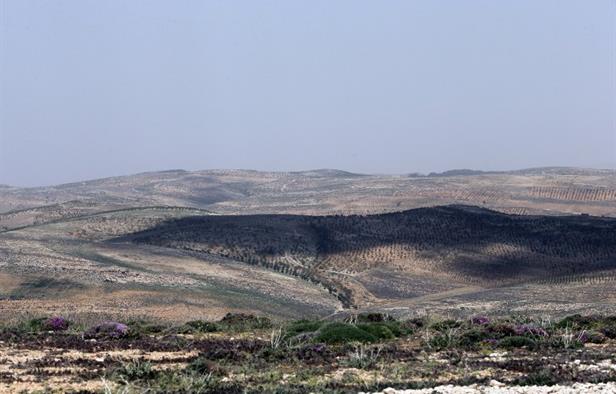Is ISIS looking to move in on the Arsal-Ras Baalbek area?
Nicholas Blanford/Now Lebanon/November 19/15
On 2 August last year, a combined force of some 700 militants, mainly drawn from Jabhat al-Nusra and ISIS, stormed into the eastern Bekaa town of Arsal, overrunning army positions and triggering a bitter battle lasting several days. Eventually the militants retreated, beaten back by the Rangers and Air Assault regiments and units of the 5th Intervention Brigade. But they took with them a large amount of captured weapons and ammunition as well as 36 soldiers and police, of whom 25 still remain hostage.
The Lebanese Army has since imposed a ring of steel around Arsal with fortified outposts, strengthened checkpoints and hilltop observation towers. But according to residents in Arsal, the militants have slipped back in and are now the dominant influence in the town.
“Daesh [ISIS] and Jabhat al-Nusra are all over Arsal and treating the people very badly,” says one resident, an active supporter of Syrian rebel groups who refused to be identified because of the security situation in the town. He added that there are tensions between ISIS and Jabhat al-Nusra and they have clashed in areas outside Arsal. Sources close to the army say that soldiers manning checkpoints on the roads and tracks that radiate out from Arsal are strict in allowing or denying access. But if no weapons are found in a vehicle and the occupants have valid identification there is little reason to deny them passage even if in fact they are Islamist militants.
The discovery over the weekend by the Internal Security Forces of 10 explosive-rigged vehicles and a larger number of explosive-rigged motorcycles suggests that considerable planning has been underway for some time to cause instability in the town or directed from the town. That belief is strengthened by the arrest of Mohammed Ahmad Hujairy, a self-confessed member of the Islamic State in Qalamoun, who stands accused of assembling some of the bomb-rigged vehicles and being behind the deadly suicide attack on 5 November targeting a meeting of the Committee of Qalamoun Scholars that left four people dead. He is also believed to be responsible for a second bomb attack the next day, when an explosive-rigged motorcycle blew up beside an army armored personnel carrier, wounding five soldiers. The motorcycle bombs were also reportedly intended to target senior figures in Arsal.
The seizure of car bombs and arrests have once more raised in the media the notion that the militants in Arsal were seeking to break out to reach Tripoli and Akkar to establish some form of stronghold on the Mediterranean coast. However, the likelihood of such a scheme achieving success is even less likely now than in the past. The army has locked down the transport routes leading out of Arsal with its fortified checkpoints. Ras Baalbek, eight kilometers north of Arsal, is similarly protected by the army, making it almost impossible for a car bomb to be driven undetected into the Bekaa, let alone large numbers of armed militants. To the south of Arsal, the terrain backing on to the Shiite-populated villages of Younine and Nahle is under Hezbollah’s control. On Thursday, a Hezbollah unit ambushed militants in Wadi Khayl, south of Arsal, killing two and capturing several others.
Even if militants were able to blast their way through army lines around Arsal to reach the Bekaa, they would then have to traverse extremely hostile territory to reach Tripoli and the coast. The northern Bekaa is the fief not only of Hezbollah but powerful Shiite tribes who can be expected to ferociously defend their villages against marauding Sunni jihadists. There are only three drivable routes meandering across the mountains linking the northern Bekaa to the Tripoli region and Akkar. All it would take to thwart access to the coast is a bulldozed pile of rocks cutting each route. Added to that, the roads pass through territory riddled with Hezbollah training camps and populated by hostile Shiite clans.
Still, the Bourj al-Barajneh suicide bomb attacks last week and the subsequent arrests of around a dozen linked suspects and the seizure of some 300 kilograms of explosive and associated bomb-making equipment would appear to confirm fears that ISIS is seeking to destabilize Lebanon, ending a 17-month hiatus in bomb attacks. Arsal’s role in all this is still unclear, but perhaps we should be looking for answers to the east of the town rather than to the west. According to residents of Arsal and sources close to Hezbollah, ISIS still has the ability to traverse the border to reach areas around Jarajeer and Qarah in the northern Qalamoun. In a possibly connected development, ISIS at the beginning of the month advanced west from the town of Qarytayn in Syria’s eastern Homs Governorate to seize the villages of Mheen and Hawarin, 16 kilometers to the west, and then attacked Sadad, 14 kilometers northwest of Mheen.
It is unclear why ISIS embarked upon a frog-jumping advance west of Qarytayn now. Heading west further extends its supply lines at a time when Russian aircraft are roaming the skies above Syria. The advance did at one point bring ISIS to within 14 kilometers of the Damascus-Homs highway, but it is doubtful that the group was seeking to cut the critical route, which connects the capital to the Mediterranean coast. Any threat to the highway would immediately draw a strong response from the Syrian regime. Indeed, ISIS was unable to take Sadad and on Tuesday reportedly lost control of Hawarin.
Sadad is populated by Assyrian Christians and its defense was aided by Russia airlifting reinforcements from the Assyrian Sotoro militia from Hasake in the northeast. A perhaps inadvertently-too-revealing televised briefing on Tuesday by the Russian Defense Ministry to Russian President Vladimir Putin showed a map that marked the Russian army’s 120th artillery brigade equipped with 152mm howitzers deployed in the vicinity of Sadad. On Sunday, Russian helicopters attacked suspected ISIS targets in the region of Qarah in the northern Qalamoun and possibly even on Lebanese soil east of Ras Baalbek.
While ISIS appears for now to be on the back foot in Mheen, perhaps the explanation for punching west of Qarytayn in the first place was to hook up with their brothers roaming the hills around Qarah and across the border in the Ras Baalbek-Arsal area. It is speculative, for sure, but if a logistical supply line could be established it might strengthen ISIS’s influence in the Arsal-Ras Baalbek area. The Qarytayn move combined with the recent suicide bomb attack against the Committee of Qalamoun Scholars and reports that Hujairy’s cell was planning to hit senior Arsal figures suggests that ISIS may be attempting to secure the town as a base of operations, using marginally more subtlety than its headlong all-guns-blazing charge of August last year.
**Nicholas Blanford is Beirut correspondent of The Christian Science Monitor and author of Warriors of God: Inside Hezbollah’s Thirty-Year Struggle Against Israel.




















